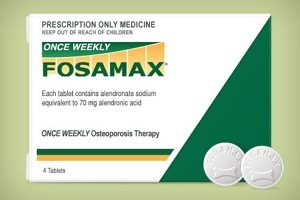
Fosamax May Cause Bone Fractures. Physicians at Weill Medical College of Cornell University are reporting that prolonged Fosamax—generically known as bisphosphonate alendronate—use may increase the risk of femur fractures, the large thigh bone that connects the leg to the hip. Continued evidence indicates that long-term alendronate use may overly suppress bone metabolism, which limits […]

Fosamax May Cause Bone Fractures. Physicians at Weill Medical College of Cornell University are reporting that prolonged Fosamax—generically known as bisphosphonate alendronate—use may increase the risk of femur fractures, the large thigh bone that connects the leg to the hip.
Continued evidence indicates that long-term alendronate use may overly suppress bone metabolism, which limits the repair of microdamage and increases fracture risk, Dr. Joseph M. Lane and colleagues report in the Journal of Orthopaedic Trauma.
To investigate this risk, the team reviewed all 70 patients with femoral fractures who were admitted to their Level 1 trauma center 2002-2007. The average patient was 75 years of age, the majority of the patients were women, and 25 patients—36 percent—were treated with alendronate.
Also, 19 of 20 patients suffering from the same fracture pattern were taking alendronate. The other patient was later diagnosed with cancer. The study also reported that the average duration of alendronate use was significantly longer in those with femoral stress fractures than in the six treated patients without this type of fracture, 6.9 years versus 2.5 years, respectively.
Otherwise, there were no significant differences in age, race, weight, or osteoporosis history among = those without and without this fracture patter.
Lane and his associates have called for more research to determine if this effect is associated with all bisphosphonate drugs and if it became apparent first with alendronate because this drug has been available for the longest time and is the most widely used.
Lane advises that, “physicians prescribing bisphosphonates for longer durations should monitor patients for indications of bone regeneration.” Lane recommends that bisphosphonates be discontinued until levels return to normal if a blood test shows a low level of bone turnover.
Meanwhile, earlier this year Canadian researchers issued a warning that bisphosphonates, sold under the names of Didrocal, Actonel, and Fosamax can lead to bone necrosis, a painful and disfiguring condition that results in bone death.
The study found that such drugs almost tripled the risk of developing bone necrosis. The study was conducted by researchers at the University of British Columbia (UBC) and McGill University and is the largest study of its kind into the connection between bone necrosis and specific brands of bisphosphonates: Didrocal, Actonel, and Fosamax.
Prior to that warning, the U.S. Food and Drug Administration (FDA) issued a warning about bisphosphonates and its link to a higher possibility of severe and sometimes incapacitating bone, joint, and muscle pain.
“I think the study’s important just basically to let the public know if they do experience any severe, unusual pain they could tell their health professional,” said Dr. Mahyar Etminan, the principle investigator from the University of British Columbia.
Use of bisphosphonates has increased as the population has aged and Etminan reported that use will likely further increase due to a possible link between estrogen use and breast cancer, prompting women to switch from estrogen therapy to bisphosphonate therapy to stop bone fractures from occurring.
The drugs like Didrocal, Actonel, and Fosamax are also becoming easier to take, with once-a-month and once-a-year doses now available.
The personal injury attorneys at Parker Waichman LLP offer free, no-obligation case evaluations. For more information, fill out our online contact form or call 1-800-YOURLAWYER (1-800-968-7529).


